
 |
Tea Clipper |
 |
| from TeaAntiques.com | ||
| Edition Thirty Nine |
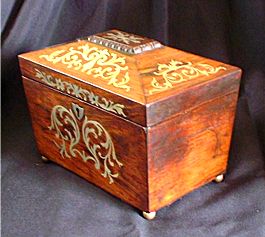 A very pretty Regency brass inlaid 'Sarcophagus' shaped Rosewood Tea Caddy,
fitted with two compartments, c1810-20.
A very pretty Regency brass inlaid 'Sarcophagus' shaped Rosewood Tea Caddy,
fitted with two compartments, c1810-20.
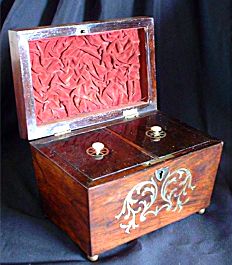 The Rosewood veneer is of a strong rich colour, with a wonderful dark grain
and is used throughout the Caddy surfaces and internal compartment lids.
The Rosewood veneer is of a strong rich colour, with a wonderful dark grain
and is used throughout the Caddy surfaces and internal compartment lids.
There are beautiful panels of inlaid brass, with scrolling symmetrical foliate designs. These striking and very decorative inlays are incorporated on the front and lid of the Caddy, with further brass embellishments on the compartment lids.
Lifting the lid of this handsome Tea Caddy, reveals a delightful interior. The lid of the Caddy on the inside is lined with crushed velvet in a subtle shade of pink.
It is certainly a most charming Regency brass inlaid Rosewood Tea Caddy, fitted with two compartments, c1810-20.
More details of this item and other tea related antiques can be found by visiting my web site at www.TeaAntiques.com.
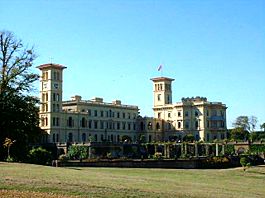 Across the short stretch of sea
from Portsmouth on the South coast of England, known as the Solent, lies the
rather sleepy Island called the Isle of Wight.
Across the short stretch of sea
from Portsmouth on the South coast of England, known as the Solent, lies the
rather sleepy Island called the Isle of Wight.
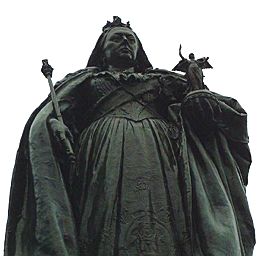 A delightful small Island, it
remains a popular resort for the English tourist, especially for those with young families;
the long sandy beaches providing a haven for children to play. Back in the
middle of the nineteenth century it was also to become a tranquil haven for
Queen Victoria, her devoted husband Prince Albert and their growing family.
A delightful small Island, it
remains a popular resort for the English tourist, especially for those with young families;
the long sandy beaches providing a haven for children to play. Back in the
middle of the nineteenth century it was also to become a tranquil haven for
Queen Victoria, her devoted husband Prince Albert and their growing family.
It was on the Isle of Wight that the Queen and Prince Albert found the perfect place in which to retreat from the pressures of their life in Buckingham Palace, London. Both the Queen and Prince Albert greatly enjoyed their life at their informal home on the Island, Osborne House was a perfect paradise.
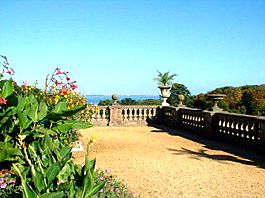 The
location of Osborne House near East Cowes is a perfect spot for a house, with
views stretching across the Solent toward Portsmouth, the bay in which it is set
was likened to the Bay of Naples by Prince Albert. On a sunny day, it is still
easy to see how he reached this conclusion, the view and the house itself having
an Italianate air about them
The
location of Osborne House near East Cowes is a perfect spot for a house, with
views stretching across the Solent toward Portsmouth, the bay in which it is set
was likened to the Bay of Naples by Prince Albert. On a sunny day, it is still
easy to see how he reached this conclusion, the view and the house itself having
an Italianate air about them
Osborne House was the creation of the Royal couple themselves. The design of the house was by Thomas Cubitt, but the Prince worked closely alongside him in all aspects of its design. It was built between 1845-51 and strongly influenced by Italian villa architectural styles
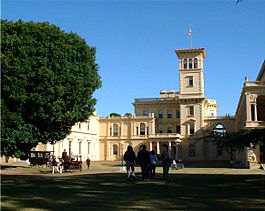 Osborne
House was to be a favourite home to Queen Victoria, a home where she could relax
with her Albert and their family, away from ceremony and state affairs. Her long
life saw not only her own young children growing up at Osborne, but followed on
by her many grand and great grand children, until her death at Osborne House in
1901.
Osborne
House was to be a favourite home to Queen Victoria, a home where she could relax
with her Albert and their family, away from ceremony and state affairs. Her long
life saw not only her own young children growing up at Osborne, but followed on
by her many grand and great grand children, until her death at Osborne House in
1901.
Today the house is open to the public and is a treasure trove of Queen Victoria, Prince Albert and her families life spent there, given to the nation by Queen Victoria’s son, Edward VII. Many of the rooms still furnished and left as they were when the Queen's body was taken back to London for the state funeral.
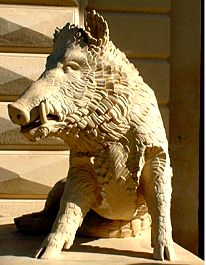
The visitor approaches the house through pleasant parkland and arrives at the front of the building, striking in appearance, the painted stucco façade of bright cream paint imitating Bath stone. Looking at the house from this aspect there is the Durbar wing to the left, the Pavilion containing the Royal Apartments set back in the centre and then the main wing and household wing to the right. It is through the main wing that you enter the house for your tour of what are some interesting and magnificent rooms and apartments. This doorway is guarded on either side by large stone wild Boar.
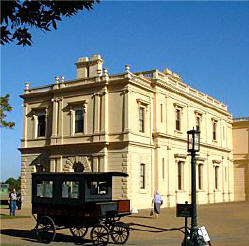
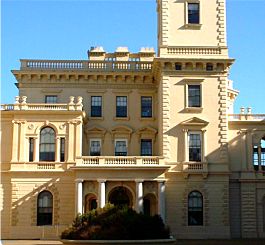
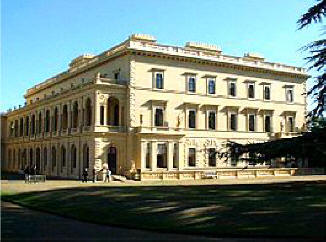
Inside there is an exhibition room which then leads to a very grand long corridor, its floor covered in stunning and brightly colourer Minton tiles and the general decoration reflecting the Prince’s liking for Italian Renaissance. He had gained many of his ideas from his tour of Italy in 1838. The plasterwork are copies of classical plaster reliefs, including the Elgin Marbles from the Parthenon, Athens. The corridor is lined with some beautiful classical statues.
Turning right off the main corridor are two very interesting rooms, the Council room and Audience room. The Council room is where the Queen's Privy Council of Ministers met several times a year. It was in this room that the Queen awarded her husband Prince Albert, the title of Prince Consort in June 1857. It is a richly decorated room, the ceiling containing the badge of the Garter and other royal emblems. From this room can be seen stunning views out across the terraces towards the Solent and Portsmouth in the distance. The door through which you enter the room is flanked by Sèvres porcelain pictures of Queen Victoria and Prince Albert. One very noticeable thing at Osborne house is the Queen’s love and devotion to her family, part of which was shown by having their images all around her, in pictures, plaster busts, and even in the plaster casts of their hands.
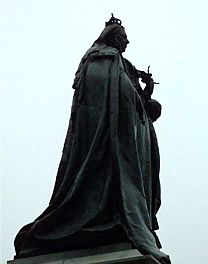 A door to the left of the
Council room leads directly through to the Audience room. In this room the
Queen would receive ministers prior to Privy Council meetings. The most striking
thing about this intimate looking room was the amazing coloured glass
chandelier. This exotic concoction of coloured glass was styled into Arum lily
flowers and Convolvulus flowers emanating from a basket. A remarkable work of
art from the opulent Victorian period.
A door to the left of the
Council room leads directly through to the Audience room. In this room the
Queen would receive ministers prior to Privy Council meetings. The most striking
thing about this intimate looking room was the amazing coloured glass
chandelier. This exotic concoction of coloured glass was styled into Arum lily
flowers and Convolvulus flowers emanating from a basket. A remarkable work of
art from the opulent Victorian period.
Returning to the main Grand corridor, the tour continues from the main wing into the central Pavilion wing. Directed firstly down a flight of servant stairs to see the Table Decker’s rooms. With the Dining room located above, these rooms were used by the servants to prepare the ornate floral table decorations, prepare the table settings and to deck the food before being served. The food had already travelled 100 metres from the kitchens to this Decker's room.
From the Decker’s rooms a narrow servant staircase leads directly up to the Dining room. Before being served, the food was arranged on a huge mahogany sideboard at one end of the room. This dining room is not exactly very grand, but has a homely and intimate feel about it. The walls painted a simple pink, with a rich red carpet on the floor and bright red curtains. A large rectangular table is surrounded by Victorian dining chairs, each with padded seat and back for additional comfort. The table is laid out for a meal of the 1890’s and a menu from this period is on the table. Dinner at Osborne was initially served at 8PM on the dot, but later in the nineteenth century the time was moved to 8.45, although the Queen would often not arrive until 9.15 when the company could then be seated to enjoy the meal. It was in this Dining room, that Queen Victoria’s body laid in state after her death in 1901.
The next room is the delightful Drawing room - a beautiful room rich in decoration and having fine marble Corinthian columns strategically placed. There are some brilliantly shining glass chandeliers hanging from the painted and gilded ceiling. The windows are decked with exquisite yellow silk curtains and some of the fine gilt furniture is covered in this heavenly yellow silk too. At the end of the room are windows, which during the day allowed light to flood into this room, by night, there were heavy mirrored shutters that could be pulled across the windows, thus reflecting the light from the graceful chandeliers back into the room. This also created the illusion of the room being much larger than it is.
The Queen would receive and entertain visiting foreign royalty in this room. Also, after sitting down to dinner, the Queen would often retire to this room to play cards or maybe to sing and play at the piano with other members of the family. There are some carved statues around the room of some of Queen Victoria’s children, these the work of Mary Thornycroft.
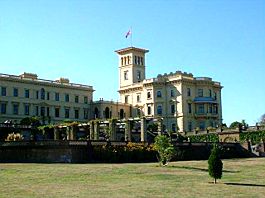 Tucked
around the corner at one end of the room is the Billiard room, not a separate
room, but out of the view of the Queen. It was not allowed for gentlemen to sit
in the presence of the Queen and, technically, this room was still within her
presence. Therefore, raised wooden benches were set along the wall of the
Billiard room where they could be semi-seated as a compromise. There were
dividing curtains that could be drawn to separate the two rooms if required.
Tucked
around the corner at one end of the room is the Billiard room, not a separate
room, but out of the view of the Queen. It was not allowed for gentlemen to sit
in the presence of the Queen and, technically, this room was still within her
presence. Therefore, raised wooden benches were set along the wall of the
Billiard room where they could be semi-seated as a compromise. There were
dividing curtains that could be drawn to separate the two rooms if required.
Leaving the Billiard room, servant stairs, which allowed access to all floors, take the visitor to the second floor containing the nursery rooms. These nursery rooms for the young children comprised the nursery bedroom, their tiny iron framed beds in rows and the nursery sitting room containing a hexagonal table and small child chairs. On this separate floor the children could be looked after by the nanny and out of sight and sound of other members of the household.
On the first floor, above the state rooms and below the nursery floor are the Queen’s Sitting room; Queen’s Dressing room; Queen’s Bedroom and the Price Consorts dressing room.
It was in the Queen’s sitting room where I felt closest to the memory of the late Queen. This splendid room has a large bow window overlooking the terraces and with very clear views towards the sea and Portsmouth beyond. The room has yellow mustard coloured painted walls, curtains of red floral material and a richly decorated floral carpet giving a wonderful homely feeling. In the centre of the room are the two writing desks positioned next to one another, here the Queen could work along side her beloved Albert. The Queen's desk has three servant bell pulls under the right-hand side, these used to summon various servants and members of her staff. Both desks are crammed with family photographs, the Queen delighting in being constantly surrounded by visions of her family.
In the Queen’s bedroom is her great bed, hung with material known as Victoria and Albert chintz, its floral design cleverly embodying profiles of the Queen and Prince Albert. After her beloved Albert’s early death from typhoid in 1861, Queen Victoria went into deep mourning for many years. On a stand next to her bed was a portrait of Prince Albert, the Queen wishing that the first thing that she saw when she woke, would be the face of Albert. His pocket watch was fixed to the head board of the bed next to another small portrait of him, a portrait that the Queen had displayed in every royal residence. Queen Victoria died in this bedroom upon a small couch in January 1901.
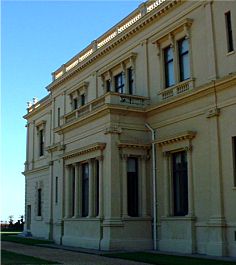
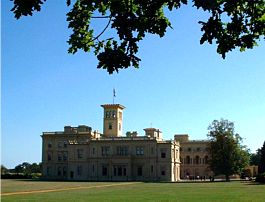 Moving on to the Durbar wing you can see the Queen’s love for her new Indian empire. The Queen became
Empress of India in 1876. The Queen and Prince Albert had entertained the
Maharaja Duleep Singh at Osborne House in 1854. There are some portraits of the
Maharaja to be seen in this unusual wing of the house. The Durbar room is a vast
room, constructed 1890-91, providing the house with a State Banqueting room. The
room took its name from an Indian word meaning both a state reception and a hall
in which gatherings are held.
Moving on to the Durbar wing you can see the Queen’s love for her new Indian empire. The Queen became
Empress of India in 1876. The Queen and Prince Albert had entertained the
Maharaja Duleep Singh at Osborne House in 1854. There are some portraits of the
Maharaja to be seen in this unusual wing of the house. The Durbar room is a vast
room, constructed 1890-91, providing the house with a State Banqueting room. The
room took its name from an Indian word meaning both a state reception and a hall
in which gatherings are held.
The Durbar room is decorated in Indian architectural style and is a marked contrast to the rest of the house. The elaborate Indian designs around the room walls are produced from plaster and carton Pierre-a form of papier mâché.
From the delights of this beautiful home, to the magnificent ground of the house there is still much more to be enjoyed. The terrace gardens on the front of the house which over looks the Solent and Portsmouth there are beautifully laid out formal parterres. From these formal terraces there are stunning views, way across the Solent busy with yachts and ships, lies Portsmouth and the hills of the South Downs forming a perfect vista.
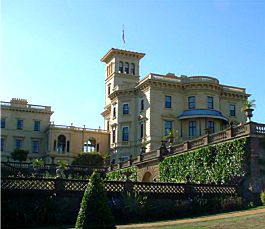
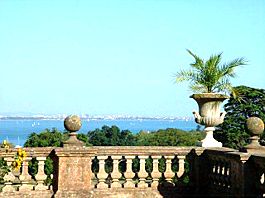
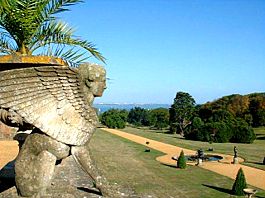
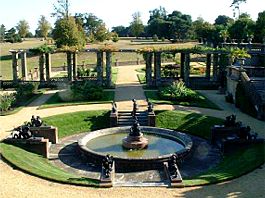
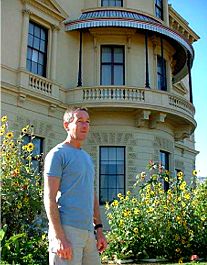 The
upper terrace of the gardens was constructed under the watchful supervision of
Prince Albert. From the terraces the whole landscape was redesigned to create
the deep valley leading away from the house to the shore of the Solent. In the
centre of the terrace below the upper terrace is the ‘Andromeda fountain’, its
circular pool surrounded by serpents on plinths.
The
upper terrace of the gardens was constructed under the watchful supervision of
Prince Albert. From the terraces the whole landscape was redesigned to create
the deep valley leading away from the house to the shore of the Solent. In the
centre of the terrace below the upper terrace is the ‘Andromeda fountain’, its
circular pool surrounded by serpents on plinths.
From the upper terrace in front of the pavilion wing, there is a view of the bow window of the Queen’s sitting room, with its semi-circular veranda. From there the Queen would enjoy the uninterrupted views.
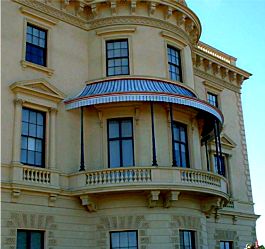
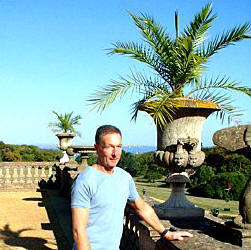
To the far left of the main wing is the tall bell tower, designed in the form of an Italianate campanile (bell tower), this design reflecting the flag tower on the Pavilion wing.
![]()
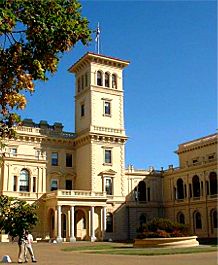
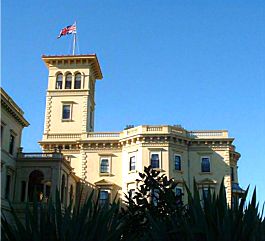
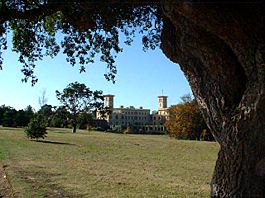 There is a half mile walk from
the house which leads past an ice house, to the Swiss Cottage and museum. The
Swiss Cottage garden was given to Queen Victoria’s children, there they would
learn the skills of gardening and producing their very own produce for the
dinner table. Each of the Princes and Princesses were given their own labelled
plot of land to tend, together with their own little wheel barrows with their
initials painted upon them and sets of child sized tools.
There is a half mile walk from
the house which leads past an ice house, to the Swiss Cottage and museum. The
Swiss Cottage garden was given to Queen Victoria’s children, there they would
learn the skills of gardening and producing their very own produce for the
dinner table. Each of the Princes and Princesses were given their own labelled
plot of land to tend, together with their own little wheel barrows with their
initials painted upon them and sets of child sized tools.
The timbered Swiss Cottage itself, was built with the aid of the royal children, the foundation stone was laid in 1853. The Swiss Cottage was constructed by estate carpenters and it was formally presented to the children in 1854 on Queen Victoria’s birthday.
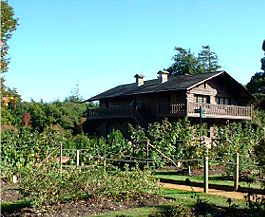
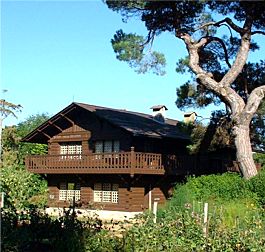
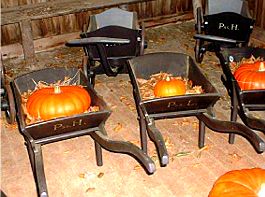
Prince Albert intended that the Swiss Cottage would provide an excellent education on cooking and house keeping for the royal children. Inside, the Cottage was furnished with child sized cookers, utensils and furniture. There is a kitchen and pantry downstairs. Then upstairs is a Lobby, Dressing room, Sitting room and Dining room. All the rooms of the cottage are beautifully furnished, looking quite comfortable and homely.
In the dining room the children would often prepare and take afternoon tea, very popular in the Victorian period. They were sometimes joined by the Queen herself, who would venture down from the house to be with them. It is easy to imagine the Queen surrounded by the children eager to show her how they had managed to prepare the tea and cakes.
Like all good Victorians, the royal children were encouraged to collect all kinds of things from nature and as their own collections grew, it was accommodated in a newly built museum next to the Swiss Cottage in 1862. This museum still contains their fine collections.
A miniature fort and barracks was constructed nearby by the Princes as a surprise birthday present for the Queen and provided them with a place in which to act as soldiers.
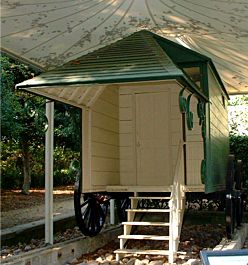
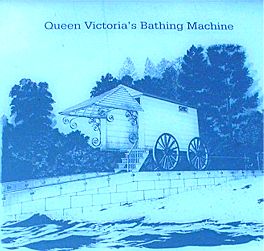 For Queen Victoria’s
own pleasure, there was a mobile beach bathing machine. This would have been on
a stone railway track running down into the sea. Thus Queen Victoria could bath
in the sea in privacy, attended by her maids. Inside the bathing machine there
was a changing room and a plumbed toilet.
For Queen Victoria’s
own pleasure, there was a mobile beach bathing machine. This would have been on
a stone railway track running down into the sea. Thus Queen Victoria could bath
in the sea in privacy, attended by her maids. Inside the bathing machine there
was a changing room and a plumbed toilet.
Afternoon tea can be taken by today's visitors in the small café at one end of the Swiss Cottage, on which I report below.
Finally, returning the half mile walk to the house and then walking to the other side of the house, there is the old walled garden, together with its glass hot houses erected in 1854. Towards the end of Queen Victoria’s life this walled garden was mainly used to grow flowers for use in the house. Today, there are once again an abundance of flowers grown in the garden.
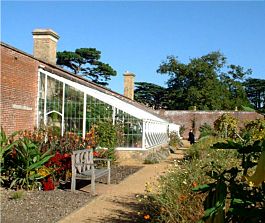
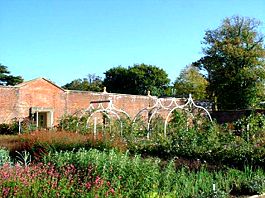
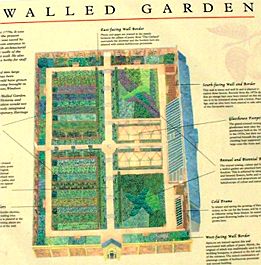
A visit to Osborne house provides a full day's entertainment and is a marvellous place to see and enjoy. Not only is the house a delight and marvel of Victorian design, the gardens and atmosphere you encounter is just so romantic. How easy to imagine the Queen and Prince Albert enjoying their relaxed life here with their beloved family.
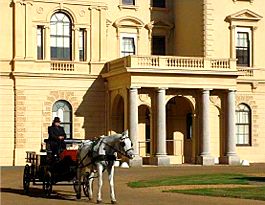
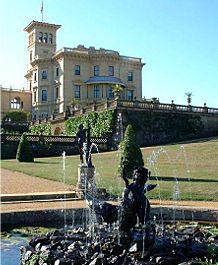
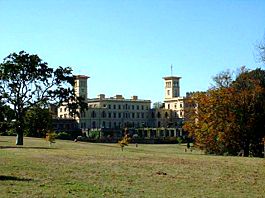
Click here for
Local Map
Map courtesy of www.streetmap.co.uk
Upon arrival at Osborne house, I took some refreshment at the cafeteria near the reception area - this I could not recommend to you, I was extremely disappointed not only by the service, but the food was in my opinion extremely poor quality.
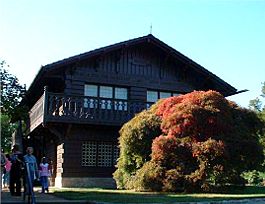
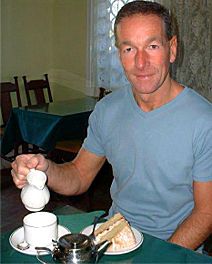 However, I can recommend that
you do take tea down at the Swiss Cottage in the grounds of Osborne house. It is
a very small eating area, but if this is full and the weather is fine, then
there are outdoor tables.
However, I can recommend that
you do take tea down at the Swiss Cottage in the grounds of Osborne house. It is
a very small eating area, but if this is full and the weather is fine, then
there are outdoor tables.
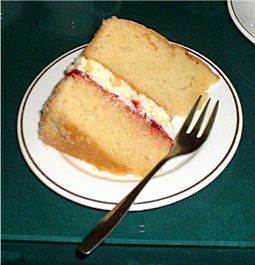 At last, I was able to take a
descent pot of tea and enjoy a slice of ‘Victoria sandwich’, that oh so
traditional light sponge cake, filled with jam and soft butter cream, the top
sprinkled with fine sugar. I would have been very disappointed had I not found
Victoria sandwich on the menu at Osborne House! I did enjoy this cake and tea
and made a perfect end to a most enjoyable day. I could just see the Queen
herself sat at this delightful cottage with her young children maybe eating a
slice of Victoria sandwich that the children had cooked with their own fair
hands. What better way to spend an afternoon.
At last, I was able to take a
descent pot of tea and enjoy a slice of ‘Victoria sandwich’, that oh so
traditional light sponge cake, filled with jam and soft butter cream, the top
sprinkled with fine sugar. I would have been very disappointed had I not found
Victoria sandwich on the menu at Osborne House! I did enjoy this cake and tea
and made a perfect end to a most enjoyable day. I could just see the Queen
herself sat at this delightful cottage with her young children maybe eating a
slice of Victoria sandwich that the children had cooked with their own fair
hands. What better way to spend an afternoon.
To review past newsletters, just follow this link:
Past newsletters.
To subscribe to this free newsletter -
Click here